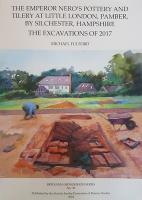
Society for the Promotion of Roman Studies (2022) p/b 200pp £30 (ISBN 9780907764502)
Michael Fulford is well known for his extensive research and writings about Silchester. But this book concerns a separate site at Little London, some 3 kilometres south-south-west of Silchester.
For about a century it has been believed that there was a Roman tilery at Little London. Among the early finds from there was a tile (now in the British Museum) stamped ‘NER[O] CL[AUDIUS] CAE[SAR] AUG[USTUS] GER[MANICUS]’. In 2015 a geophysical survey by Historic England revealed the presence of eight kiln-type structures. The first systematic investigation was carried out in 2017 under Fulford’s supervision. This revealed a tilery which had been operating in the period soon after the Roman conquest of southern Britain. Besides the kiln structures, the excavation revealed just over 17,500 pieces of ceramic building material. Clearly this was the source of roof tiles used in Silchester. Several of the tiles found in Silchester and at Little London bear the name of Nero (Emperor AD 54-68), which enables us to date the tilery with unusual accuracy. It is the earliest known tilery in Roman Britain.
The 2017 investigation involved digging two trenches, in an area where the geophysical survey indicated the presence of kilns. Surprisingly, the kilns found in Trench 2 were primarily for the production of pottery. Pottery fragments are generally easier to date than tiles. These too support the view that operations on the site occurred between the mid-first century and the early Flavian period. This reviewer visited Little London on 29 August 2017, at Fulford’s invitation, and saw both the tile kilns and the pottery kilns that were being uncovered.
This book provides a very full account of the 2017 excavations. There are ten chapters. Fulford has written chapter 1 (Introduction) and chapter 10 (Concluding Discussion). A group of specialist contributors, including Fulford, have written the intervening chapters. Chapter 2 describes the geophysical survey. Chapter 3 is an account of the excavations, including some very fine photographs of the kilns. Chapter 4 is focused upon the pottery, with a comprehensive table and description of the finds. Chapter 5 describes the ceramic building materials recovered, again with many coloured photographs. Chapter 6 by Catherine Barnett provides an analysis of the wood charcoal remains. These came from six bulk sediment samples. Radiocarbon dating reveals that all the kilns had a short phase of use. Barnett suggests that the managed woodland and pattern of cropping had been established around Silchester and Little London in the late Iron Age, and this continued during the Roman period. Other chapters discuss charred plant remains, the links with Silchester Insula IX and archaeomagnetic investigation. There are nine appendices, which develop the details.
In chapter 10, Fulford draws together his conclusions. The excavations have revealed three adjacent brick kiln structures and three smaller pottery kilns. The total number of kilns is unknown, because a large area of the site has been disturbed. Combining all of the dating evidence from tile stamps, pottery, and radiocarbon analysis, it is likely that the site was operating between about AD 50 and AD 80. The main kilns were producing a wide range of ceramic building material including bricks used for string courses, flue-tiles, vaulting tiles and pilae (for construction of bathhouses and heated rooms). These materials would have been needed for high status residences and possibly—in Fulford’s view— for mansiones. The author goes on to speculate that Polyclitus, whom Nero sent to conduct an inquiry after the Boudiccan rebellion, may have set up his headquarters in Silchester. That would certainly seem possible since London, St Albans and Colchester had all been razed to the ground by the avenging queen. Fulford also suggests that Classicianus, the procurator who did so much to restore stability to the province during the 60s, may have set up a temporary base at Silchester. That too seems possible, for essentially the same reasons. If this is correct, that may explain why kilns were operating in Little London for a relatively short period, producing high quality building materials and pottery.
This is definitely not a book for the general reader. It is a book for archaeologists and serious students of Roman Britain. For such readers, this book has much to offer. Both the main chapters and the appendices are packed with useful data.
Rupert Jackson
